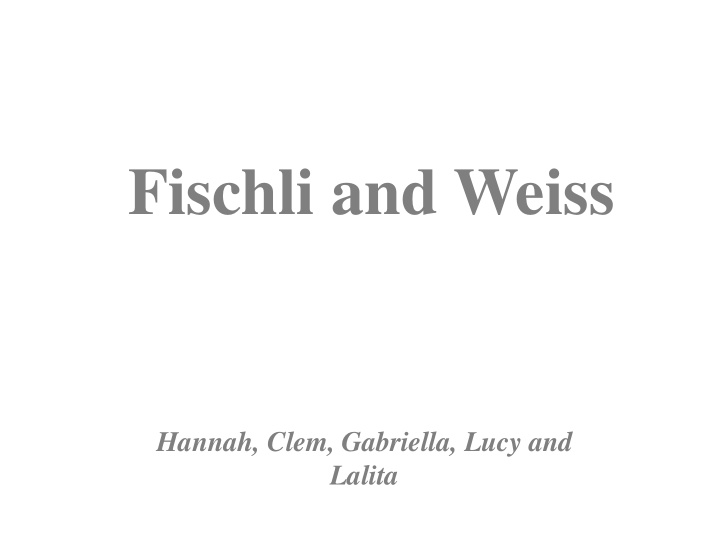



Fischli and Weiss Hannah, Clem, Gabriella, Lucy and Lalita
Main information on the artists *Peter Fischli (born in 1952) *David Weiss (born in 1946) - Started in the late 1970s and worked with a wide range of media including sculpture, installation, moving image and photography. - In their work everyday objects take on a lifelike quality, they play off each other and collide in unexpected ways that are often witty.
Outlaws, 1984 Materials, composition and colours * Two chairs balanced on top of a long tube, an empty glass bottle and a pot * Worn, recycled * Mundane and bland, colours, something you’d come across really regularly *Interesting use of shadow through the gaps of the chairs
A quote about this artwork “These two astute observers collect objects and impressions, which they then transform in their work in order to present an altered view of reality. “ From a book by Fischli and Weiss Flowers and Questions: A retrospective
Is this a surrealist piece? Is this piece: Photo-shopped? - It seems impossible for the objects to remain in that specific position. Reinforced by an invisible material? - string perhaps? Adhesive? Something real made to look unreal?
Flowers and questions “ A number of the sculptures give physical form to contrary states, but blur the distinction between them in the process, suggesting that difference is not innate, but lies, rather, in perception.” p. 126
What does the title mean?!?! Outlaws - could refer to the way in which the sculpture defies the laws of gravity - it is an ‘outlaw’ in the sense that it is going against the rules. Social implications? Is this a commentary of everyday household life? - Things may always seem to be out of place in a household but that’s what makes it a home to people in various ways.
Another piece from their series “A Quiet Afternoon” - when these objects collapse it won’t be quiet. Perfectly balanced – kitchen items.
Reality of this piece - Outlaws This piece uses the camera’s ability to elasticate time, presenting a split-second of the sculpture. This creates a sense of preservation even though the photograph foretells what happens (crashing down of objects).
Influences of other artists M.C Escher? •A distortion of reality •Playing with concepts as he created vanishing points as an equilateral triangle Relativity, 1953 Joseph Kosuth? Bert Loeschner? •Real chair, image of a chair, •Chairs are given human definition of a personas chair. •What’s a chairs main purpose? One and three chairs, 1965 The dudes
The Way Things go - https://www.youtube.com/watch?v=GXrRC3pfLnE&t=74s
An Article by Rachel Wells in Art history (volume 36 June 2013) • I will argue that the cleverness of improbable balance in Equilibre/Quiet Afternoon suggests a different alignment: one which counters a Baudrillardian resignation at both the omnipotence of the ‘principle of equivalence’ and the subsequent ambivalence that results from the asymmetry of his diagnosed ‘impossible exchange barrier’
References •Fischli, Peter, Tate, Kunsthaus Zürich, and David Weiss. Fischli Weiss: Flowers and Questions - A Retrospective . 2nd ed. Edited by Bice Curiger. London: Tate Gallery Pubn, 2006. •Wells, Rachel. “Fischli and Weiss’s Equilibre/quiet Afternoon (1984- 5).” Art History 36, no. 3 (May 16, 2013): 626–39. doi:10.1111/1467- 8365.12020.
Recommend
More recommend